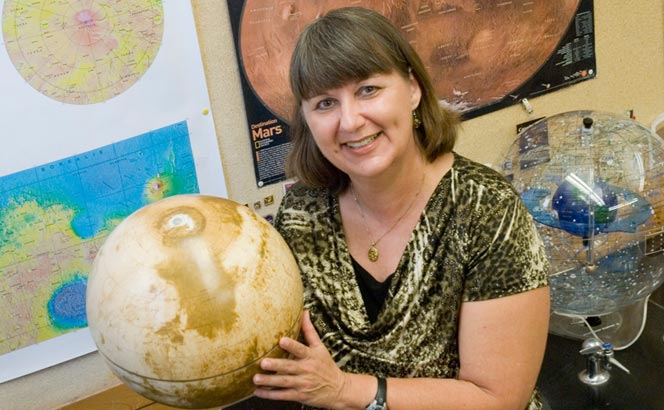Nadine Barlow may be keeping her eyes on Mars, but a faint asteroid zipping along an orbit between the red planet and Jupiter has her name on it.
The asteroid, 15466 Barlow, was named in her honor by the International Astronomical Union. Now, years later, the Northern Arizona University professor of physics and astronomy finally has the official plaque.
Barlow received the plaque in March at the Lunar and Planetary Science Conference in Houston. Longtime collaborators Faith Vilas, from the Planetary Science Institute, and Joe Boyce, from the University of Hawaii, handled all the details, making sure Barlow would have something on her wall to signify the achievement.
“It seems to be a very well-behaved main belt asteroid and there’s nothing too exciting about it,” Barlow said, light-heartedly deflecting any suggestion that the space rock reflects her personality. “But what I think is really cool is that it was discovered here in Flagstaff at Lowell Observatory.”
That discovery took place at the Anderson Mesa Station in 1999, and the naming originated as a way to acknowledge Barlow’s place as one of the world’s foremost experts on Martian impact craters.
“It’s a very nice recognition of the work I’ve done, and the fact that my colleagues recognize it and are happy with it,” Barlow said.
The pace of that work continues at a prodigious pace and along numerous lines of pursuit. Research findings about low-aspect-ratio layered ejecta craters, on which Boyce collaborated, are to be published in the planetary science journal Icarus. Barlow recently participated in a panel discussion about recent discoveries from spacecraft exploration at the Brookings Institution in Washington, D.C., and she has also been busy working with a team of analysts within the Mars Exploration Program Analysis Group.
The researchers are analyzing “special regions” on Mars: areas where Martian life could potentially exist, or where terrestrial microbes could survive and propagate if they hitched a ride on a probe from Earth.
“I was asked to participate because of my expertise with impact craters and how they might tie in to heating up the environment,” Barlow said. She explained that near-surface ice is common on Mars, so a large enough impact in such an area could create a warm and wet environment hospitable to microbes.
“Spacecraft going to the surface of Mars are sterilized but the level of sterilization depends on where they’re actually going,” Barlow said. “There are a few areas where you’d have to be very cautious about introducing microbes.”
Barlow and the rest of the group expect to finish writing their findings this summer. But when she has the time and the proper telescope access, she wouldn’t mind catching a glimpse of a certain asteroid. 15466 Barlow isn’t expected to come any closer to Earth than 4.1 million miles, and that won’t be until 2166.
“At least it doesn’t look like it’s one of those asteroids that’s going to threaten the Earth,” Barlow said. “That’s the kind of asteroid you don’t want named after you.”



